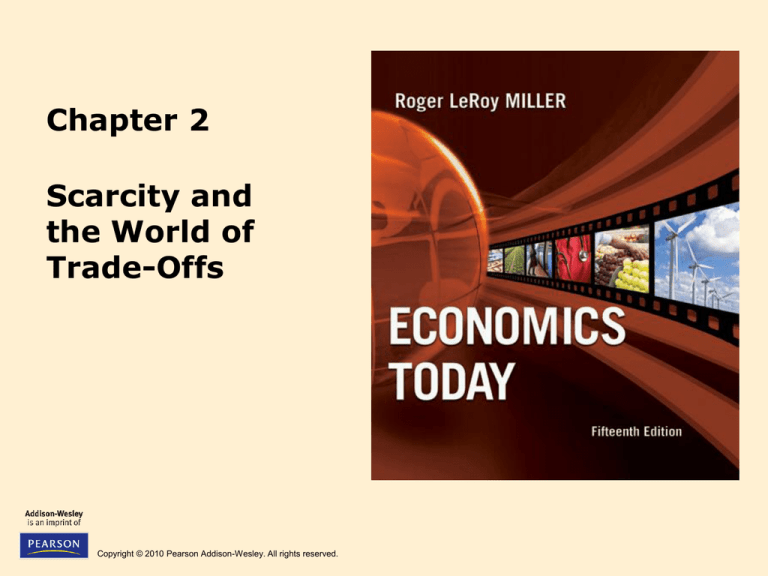
Chapter 2
Scarcity and
the World of
Trade-Offs
Copyright © 2010 Pearson Addison-Wesley. All rights reserved.
Scarcity
• Scarcity
– Is the most basic concept in all of economics
– Occurs when the ingredients for producing things
that people desire are insufficient to satisfy all
wants
– Means we never have enough of everything,
including time, to satisfy our every desire
2-2
Copyright © 2010 Pearson Addison-Wesley. All rights reserved.
Scarcity (cont'd)
• What scarcity is NOT
– It is not a shortage.
• Why? You can eliminate a
shortage by supplying more
or by reducing the quantity
demanded through raising
the price
– It is not the same thing as
poverty.
• Why?
2-3
Copyright © 2010 Pearson Addison-Wesley. All rights reserved.
Scarcity (cont'd)
• Production
– Any activity that results in the conversion of
resources into products that can be used in
consumption
• Resources or Factors of Production
– Inputs that are used to produce things that
people want
2-4
Copyright © 2010 Pearson Addison-Wesley. All rights reserved.
Resources (Factors of Production)
– Land (natural resources or the gifts of nature)
– Labor (human resource)
– Physical Capital
• All manufactured resources
– Human Capital
• Accumulated training and education of workers
– Entrepreneurship
• Risk taker
• Maker of basic business policy decisions
2-5
Copyright © 2010 Pearson Addison-Wesley. All rights reserved.
Scarcity (cont'd)
• Recall
– Scarcity occurs when the ingredients (resources)
for producing things that people desire are
insufficient to satisfy all wants.
• Needs
– To economists, the term need is not definable.
• Wants
– Goods and services on which we place a positive
value
– People have unlimited wants.
Copyright © 2010 Pearson Addison-Wesley. All rights reserved.
2-6
Scarcity, Choice, and
Opportunity Cost
• Opportunity Cost
– The highest-valued, next-best alternative that
must be sacrificed to obtain something or to
satisfy a want (forgone opportunity)
– Or ask yourself: What would you do if you did
not do this?
• What would you do if you didn’t come to school?
• What would you do if you didn’t go to college?
2-7
Copyright © 2010 Pearson Addison-Wesley. All rights reserved.
Scarcity, Choice,
and Opportunity Cost (cont'd)
Limited Resources & Unlimited Wants
Scarcity
Choices
Opportunity Cost
2-8
Copyright © 2010 Pearson Addison-Wesley. All rights reserved.
The World of Trade-Offs (cont'd)
• Opportunity cost graphically
– The production possibilities curve (PPC)
represents all possible maximum combinations
of total output that could be produced.
– Along the production possibilities curve, there is
a fixed quantity of productive resources of a
given quality being used efficiently.
• Consider…
– You are taking two courses, MATH and ECON…
2-9
Copyright © 2010 Pearson Addison-Wesley. All rights reserved.
Figure 2-1 Production Possibilities Curve for
Grades in Mathematics and Economics (Trade-Offs)
Z
W
2-10
Copyright © 2010 Pearson Addison-Wesley. All rights reserved.
The World of Trade-Offs (cont'd)
• The Production Possibilities Curve (PPC)
– What would happen to the production
possibilities curve if you spent more time
studying? 12 hours to 20 hours
– What would happen to your potential grades?
2-11
Copyright © 2010 Pearson Addison-Wesley. All rights reserved.
The Choices Society Faces
• PPC is used to demonstrate related concepts
of scarcity, choice, and trade-offs
– At the individual level
– At the societal level
2-12
Copyright © 2010 Pearson Addison-Wesley. All rights reserved.
The Choices Society Faces
(cont'd)
• Production possibilities assumptions
– Resources are fully employed
– Resources are fixed for the time period
– Technology does not change over the time
period
2-13
Copyright © 2010 Pearson Addison-Wesley. All rights reserved.
The Choices Society Faces
(cont'd)
• Efficient Point
– Any point on the production possibilities curve at
which resources generate the maximum possible
output (point ??)
• Inefficient Point
– Any point below the production possibilities
curve at which resources do not generate the
maximum possible output (point ??)
2-14
Copyright © 2010 Pearson Addison-Wesley. All rights reserved.
Figure 2-4 Economic Growth
Allows for More of Everything
• Economic growth
– Increases the production
possibilities of both
goods
– Occurs over a period of
time
– Is illustrated by an
outward shift of the
production possibilities
curve
2-15
Copyright © 2010 Pearson Addison-Wesley. All rights reserved.
Specialization and
Greater Productivity (cont'd)
• Division of Labor
– Assigning different workers different
tasks to produce a good or service)
– Organizing a division of labor within
a firm to increase output
• Examples
– Automobile production
– Hospital operating room
Henry Ford’s Model T: mass production
w/ assembly lines
2-16
Copyright © 2010 Pearson Addison-Wesley. All rights reserved.
Myth #2: I can have the cake and eat
it too.
• Nothing is “free” in this world
• …including freedom
• The problem is: Can you or are you willing
to pay the “price”?
• For example: Are you willing to pay the
“price” for an A in this class? Over 80% of
students are NOT.
2-17
Copyright © 2010 Pearson Addison-Wesley. All rights reserved.








